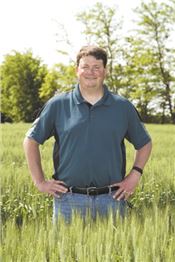War On Fusarium

Focusing on scab management was Dr. Carl Bradley,
extension plant pathologist at the University of
Kentucky. He explains the biology of the pathogen
and how to manage the disease.
Photo by John LaRose, Jr.
Fungicide, Variety Selection, Management Can Curb Blight
BETTY VALLE GEGG-NAEGER
MidAmerica Farmer Grower
PRINCETON, KY.
Head scab management was the focus of Dr. Carl Bradley, extension plant pathologist with the University of Illinois, at a wheat meeting before heading to the University of Kentucky on July 1, to work on disease management in grain crops, including wheat, soybean and corn.
Bradley explained the biology of the pathogen and disease and how to manage that.
“The fungus that causes this disease is known as Fusarium graminearum,” he said. “It’s the same fungus that causes ear and stalk rot of corn. We call it Gibberella on corn, but it is the same fungus. Fusarium head blight can be a real issue whenever conditions are favorable which includes frequent rains, cloud cover, and moderate temperatures, anywhere from 60s to high 70s. When wheat begins to head out and flower, it becomes susceptible to this disease.”
When all those things come together, head scab can be a real issue, causing yield losses; however the major issues are quality losses which include low test weight and grain contamination by a toxin known as deoxynivalenol, often referred to as DON or vomitoxin. The head scab fungus produces this toxin and can contaminate the wheat grain. This toxin is regulated, so whenever there is a high level of vomitoxin in wheat, discounts may be applied at the elevator, or the grain may be rejected if the level is too high.
“Actually, regulation starts once it’s at two parts per million,” Bradley said. “So if you have two parts per million or higher, then you can have an issue with vomitoxin.”
There are three primary ways to manage head scab and vomitoxin. Application of an effective fungicide at the appropriate timing is one of the ways. Through multi-state university testing, Prosaro, from Bayer CropScience, and Caramba, from BASF, have been identified as the products that provide the greatest reduction in head scab and vomitoxin.
“Even though these two fungicides are the best available, we don’t see complete control with the use of fungicides alone,” he reported. “We may see up to 50 percent to 60 percent control, which, if you have a very susceptible variety and conditions that are very favorable, that’s not going to be enough.”
Bradley suggested farmers need to think about other management practices to include along with using fungicides. The best timing for applying fungicides would be right when the heads begin to flower and the anthers are coming out of the middle part of the head; there is a little bit of a window up to six days after that time that can provide a similar level of control.
Another management practice is to use crop rotation.
“We know that corn is also a host for this pathogen and a lot of the spores that infect the wheat heads come from corn debris that’s on the soil,” he said. “We’ve done some studies showing that you can reduce the amount of vomitoxin and scab in a field by a little bit, if you’re following soybean versus corn. However, there isn’t a huge benefit from that practice; and, in some cases from a production standpoint, it does make sense to follow corn if you’re in an area such as southern Illinois or western Kentucky where corn may be harvested first and you want to plant wheat timely.
“The best thing that you can do is choose a variety with a high level of resistance to head scab, that’s the number one thing,” Bradley said. “From our data where we’ve looked at multiple locations, we’ve seen the combination of a resistant variety; following soybean, with Prosaro or Caramba fungicide applied at the right time, we can get up to almost 90 percent control of vomitoxin relative to planting a susceptible variety following corn without a fungicide. So you can actually get a high level of control of disease and toxin if you integrate several management practices.” ∆
BETTY VALLE GEGG-NAEGER: Senior Staff Writer, MidAmerica Farmer Grower